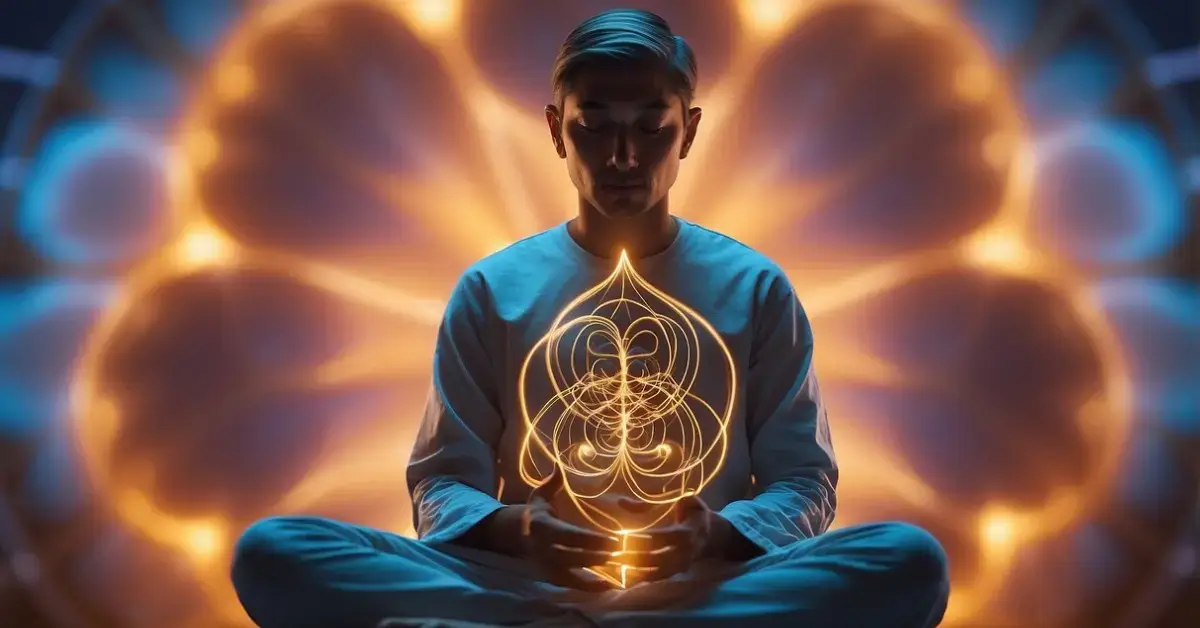Unlock the mysteries of spiritual energy by understanding the “Kundalini meaning.” Dive into its significance and discover how it can transform your life.
Understanding Kundalini: Origins and Principles
Kundalini refers to a powerful, latent energy believed to reside at the base of our spine. This energy is often depicted as a coiled snake and plays a significant role in spiritual and physical practices.
An Introduction to Kundalini and Its Sanskrit Roots
Kundalini originates from the Sanskrit word “kuṇḍalinī,” which translates to “coiled snake.” In Hinduism, it represents divine feminine energy or Shakti. This energy is often depicted as a serpent coiled at the base of the spine, waiting to be awakened.
The concept of Kundalini dates back to ancient texts like the Upanishads, which describe it as a potent force within each individual. When awakened, it is believed to unlock an individual’s full potential, leading to spiritual enlightenment and heightened physical capabilities.
The Role of Chakras in Kundalini Energy Flow
Chakras are energy centers within the body that play a critical role in Kundalini energy flow. There are seven main chakras: Muladhara (root), Svadhisthana (sacral), Manipura (solar plexus), Anahata (heart), Vishuddha (throat), Ajna (third eye), and Sahasrara (crown).
When Kundalini energy awakens, it rises through these chakras via the central channel known as the sushumna. Each chakra has distinct attributes and functions, and the Kundalini energy activates these centers sequentially, supposedly leading to a more balanced and enlightened being.
Kundalini and Its Connection with the Spine
The spine is crucial in the concept of Kundalini as it acts as the main pathway for this energy. Kundalini is believed to reside at the muladhara chakra, located at the base of the spine.
As the energy awakens, it travels upwards along the sushumna channel, which runs through the center of the spine. This journey is often compared to a serpent uncoiling and moving upwards. Proper alignment and health of the spine are considered essential for a successful Kundalini awakening and the smooth flow of energy through the chakras.
Maintaining physical spine health is therefore emphasized in practices aimed at awakening Kundalini, such as yoga and meditation.
Practices for Kundalini Awakening

Diving into practices for Kundalini Awakening involves a blend of physical movement, controlled breathing, and mindful meditation. These techniques are designed to stimulate and guide the Kundalini energy along its path.
Kundalini Yoga: A Synergy of Movement and Focus
Kundalini Yoga harnesses the combination of body movement and mental concentration. It involves performing specific asanas (poses) alongside mudras (hand gestures) to channel energy effectively.
Kriyas, or sequences of poses, are integral to this practice. These structured movements foster an intense focus, engaging both the body and mind.
When I practice, I focus on becoming aware of my body’s sensations and energy flow, enhancing my awareness and presence.
The Power of Breath: Pranayama Techniques
Breathing, especially through pranayama techniques, is essential in awakening the Kundalini. These practices include Breath of Fire, a rapid and rhythmic breath technique that promotes energy flow.
There is also Alternate Nostril Breathing, which balances the body’s energy channels. By paying careful attention to the breath, I can direct the flow of Kundalini energy more effectively.
Pranayama not only invigorates the body but also cultivates a deep sense of mental clarity and focus.
Meditation and Mantras: Tools for Kundalini Activation
Meditation is a cornerstone in activating Kundalini energy. It involves sitting quietly, focusing inward, and using specific mantras or chants. For instance, the mantra “Sat Nam” translates to “Truth is my identity” and is frequently used to anchor my awareness.
Chanting mantras repeatedly during meditation can help in tuning the vibration of the body and aligning it with the rising Kundalini energy. I often find that when I use these mantras, I can more easily attune to my inner self and the movement of energy within my body.
The Impact of Kundalini on Mind, Body, and Spirit

Experiencing Kundalini awakening can have profound effects on one’s physical health, mental clarity, and spiritual development. Each area of impact—mind, body, and spirit—experiences unique changes and benefits.
Physical and Psychological Benefits of Kundalini Practice
Engaging in Kundalini practices often leads to numerous physical and psychological benefits. I have found that many people, including myself, experience improved mental clarity and a clear mind due to enhanced deep breathing techniques such as pranayama breathing exercises.
Physically, various energy centers in the body, like the root chakra and crown chakra, become activated, resulting in heightened life energy and decreased anxiety. Physical sensations such as tingling or warmth at points like the navel or ajna are common and signify the release of dormant energy.
Kundalini and the Journey to Enlightenment
Kundalini awakening is not just a physical journey; it is a holistic spiritual practice that aims for spiritual enlightenment and self-realization. Through practices like kundalini meditation and assuming the prayer pose or gyan mudra, I feel a deep connection to divine energy and experience moments of bliss and joy.
Kundalini shakti often guides individuals, including myself, towards compassion and improved intuition. Spiritual teachers emphasize surrendering to this divine feminine energy, facilitating an enlightenment journey where the subconscious mind is harmonized with the conscious mind, leading to a greater sense of creativity and inner peace.
Integrating Kundalini Experiences into Daily Life
Bringing the experiences from Kundalini awakening into daily life has truly transformational effects. Personally, kundalini shakti taught me the importance of maintaining balanced energy centers, allowing me to approach life with renewed happiness and mental clarity.
Regular practice helps in overcoming challenges with improved communication and emotional stability. Incorporating practices like deep pranayama and maintaining poses such as the gyan mudra into daily routines helps manage anxiety and fosters a deeper connection with the soul and the divine.
In essence, integrating the physical sensations, mental insights, and spiritual encounters from kundalini practices can lead to a more balanced, joyful, and spiritually enriched life.
FAQ – Kundalini Meaning
What does kundalini energy feel like?
Kundalini energy often feels like a warm, tingling sensation rising up the spine. Some describe it as waves of bliss, heightened awareness, or a deep sense of connection to the universe.
How to know if Kundalini is activated?
Signs of Kundalini activation include physical sensations (like tingling or heat), emotional release, increased intuition, vivid dreams, and a profound sense of spiritual awakening.
What are the disadvantages of kundalini awakening?
Potential disadvantages include overwhelming emotions, physical discomfort, mental confusion, or anxiety. It’s essential to approach Kundalini awakening with guidance and readiness to integrate these intense experiences.
If you liked this blog post about the topic: Kundalini Meaning, don’t forget to leave me a comment down below to tell me about your experience with it. Or have a look at my other articles:
- Why Is Kundalini Yoga Dangerous? Understanding the Risks
- Kundalini Energy: Unlocking Your Inner Potential
- How To Connect With Your Higher Self: Simple Steps
- White Aura: Discovering Its Meaning And Benefits
- How Many Spiritual Gifts Are There: A Friendly Guide
- How to Be More Spiritual: Simple Daily Practices
Feel free to also check out our other Articles from the category “Spirituality“ and don’t forget to follow us on Pinterest.


